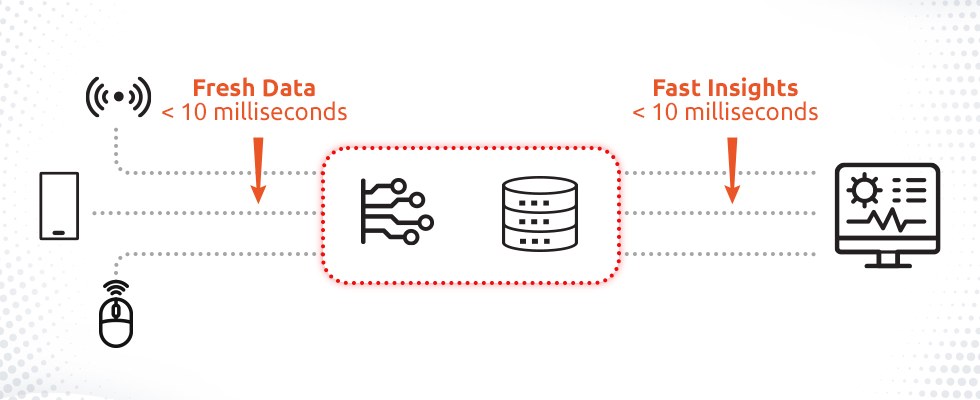Key Takeaways
- Enterprises possess vast amounts of data but often lack the necessary tools and infrastructure to leverage its full potential.
- Real-time data platforms enable organizations to analyze, decide, and act upon massive volumes of streaming data in true real-time (10 milliseconds or less).
- Benefits of real-time data platforms include faster time to insight, enhanced customer experiences, improved operational efficiency, and better risk management.
- Challenges of real-time data platforms include handling high data volumes, achieving true real-time processing speeds, and ensuring data accuracy and consistency.
- Common use cases for real-time data platforms include business support systems, fraud prevention, hyper-personalization, and Internet of Things (IoT) applications.
In a world where 2.5 quintillion bytes of data are generated each day, enterprises have more data under their control than ever before. Unfortunately, many organizations lack the tools, infrastructure, and architecture needed to unlock the full value of that data.
Just like you can’t finish a puzzle without all of the pieces, organizations can’t make the best decisions without being able to leverage all of the data they have at any given time. In order to maximize the promise of their data, enterprises need a real-time data platform that enables them to analyze, decide, and act upon massive volumes of streaming data in true real time — 10 milliseconds or less.
In this article, we examine real-time data platforms, their benefits and challenges, and some popular use cases.
Table Of Contents
Real-time data platform defined
A real-time data platform is designed to ingest, process, analyze, and act upon data instantaneously — right when it’s generated or received.
With a real-time data platform in place, organizations can collect, store, and analyze data in real time, enabling them to make immediate decisions and take timely actions based on the insights they uncover.
Real-time data platforms often utilize technologies like streaming data processing, in-memory databases, and advanced analytics to handle large volumes of data at high speeds. Some of the most common use cases for real-time data platforms include business support systems, fraud prevention, hyper-personalization, and Internet of Things (IoT) applications (more on this in a bit).
What are the benefits of a real-time data platform?
Today’s leading organizations are increasingly investing in real-time data platforms due to the myriad benefits they provide.
Faster time to insight
Real-time data platforms help organizations make more timely decisions by providing immediate access to up-to-date information. As a result, they’re able to respond swiftly to changing market conditions, customer needs, and operational challenges.
For example, an e-commerce company can use real-time data on website traffic and customer behaviors to adjust pricing or launch targeted promotions during peak shopping periods. Similarly, a logistics business can leverage real-time data on traffic conditions and shipment statuses to optimize delivery routes and schedules, ensuring timely deliveries and customer satisfaction.
Enhanced customer experiences
By enabling hyper-personalization and rapid responses to customer needs, real-time data platforms enhance the customer experience.
An online clothing company, for example, can use real-time data on past purchases and browsing behavior to recommend relevant products to customers in the moment, improving engagement and conversion rates. At the same time, a telecommunications company can leverage real-time data to proactively address service issues, minimizing downtime and enhancing customer satisfaction.
Taken together, real-time data platforms enable businesses to deliver seamless, tailored experiences to their customers, which fosters loyalty and builds the foundation needed for a productive long-term relationship.
Improved operational efficiency
Real-time data platforms enhance operational efficiency by providing timely insights and automating processes.
As an example, an industrial company can use real-time data on equipment performance to enable proactive maintenance, minimizing downtime and optimizing resource allocation. Similarly, a network port manager can use real-time data to streamline port operations, ensuring that automated guided vehicles (AGVs) can navigate the space efficiently, avoiding congestion and streamlining container movement.
As an added bonus, as operational efficiency improves, margins increase and money is spent more effectively.
Better risk management
By providing timely insights into potential risks and threats, real-time data platforms enhance risk management.
For example, a financial services company can monitor market data in real time, enabling them to detect anomalies or unusual trading patterns that may indicate fraudulent activities. In a similar fashion, a cybersecurity team can analyze network traffic data in real time to identify and mitigate potential threats before they escalate into security breaches.
When organizations can analyze data as it is created, they can proactively identify and address risks, protecting their assets, their data, and their reputation.
What are the challenges of real-time data?
While the benefits of a real-time data platform speak for themselves, not every solution is created equal. As you begin looking for a real-time data platform to power your applications, here are three key challenges to consider.
High data volumes
Making the most of a real-time data platform starts with ensuring it’s capable of processing massive volumes of data. As data streams in at a high clip, your platform needs to be able to efficiently handle and analyze all of it to uncover timely insights. Processing such high data volumes requires robust infrastructure and scalable architecture designed for high performance and high availability.
True real time
The real-time data platform you select should be able to move at the speed of actual real time — in just a few milliseconds.
One common problem for real-time data platforms is latency, particularly at scale. High latency often slows down time to insights, which reduces the organization’s ability to use timely information for decision-making. These delays can be particularly problematic in high-stakes environments, such as financial trading or industrial automation where split-second decisions can mean all the difference in the world.
To avoid latency slowing down your data processing capabilities, look for a platform built specifically for real-time data that can scale out horizontally. If you pick a platform built with layered architecture, you’ll add extra congestion to your stack, which increases latency and introduces the potential for inconsistency and errors.
Accuracy and consistency
You might be able to analyze data immediately. But what if that data is bad to begin with?
For any real-time data use case, ensuring accurate, consistent data is a top priority. Organizations must implement robust data validation mechanisms and look to manage data errors, duplication, and inconsistencies. Otherwise, they will start making decisions based on untrustworthy or incomplete data — and incurring the associated risks.
Real-time data platform use cases
Now that you have a better idea of the benefits and challenges of real-time data platforms, let’s examine some common use cases for this transformative technology.
Business support systems
Real-time data platforms can be used to power business support systems (BSS), enabling telcos to make the most of the 5G moment. Such platforms can analyze network traffic, performance metrics, and subscriber behavior to optimize network capacity allocation, predict and prevent service disruptions, and prioritize traffic during peak usage periods — all of which work together to enhance the customer experience.
At the same time, telcos can use real-time data platforms to process real-time customer data about preferences, usage patterns, and service inquiries, enabling them to offer targeted promotions and proactive support in real time.
Fraud prevention
By analyzing large swaths of data in real time, organizations can make crucial, fraud prevention decisions in the moment, protecting their data and assets.
For example, a system can flag a big-ticket purchase from a new overseas account or several failed login attempts to an account from an unfamiliar device — all within 10 milliseconds. As a result, the organization is able to take immediate actions like blocking transactions, requesting additional information, or temporarily disabling accounts to protect against fraud losses.
Hyper-personalization
In an age where customers expect personalized experiences, real-time data platforms can help organizations set the gold standard. By analyzing massive data sets in real time and recommending relevant products, entertainment options, or services in the moment, a real-time data platform can help organizations hyper-personalize the customer experience, leading to increased revenue and loyalty.
For example, an e-commerce company might recommend cooling racks, mixing bowls, spatulas, and measuring cups to someone who just bought two baking sheets. Did the person recently buy a book about baking cookies? The company could then recommend cookie cutters, cookie dough, and chocolate chips. In many ways, it’s like reading the customer’s mind.
IoT applications
Real-time data platforms can also power a number of IoT applications. By continuously streaming data from connected devices at a high velocity and analyzing it immediately, systems can react to new developments instantly — something that’s not possible with batch processing.
For example, imagine a sensor on a piece of manufacturing equipment detects an abnormal spike in temperature, which typically signals a potential failure. Using this information, the sensor could automatically trigger an alert for maintenance, enabling organizations to fix the machine before it gets knocked offline, maintaining production. In an industry where downtime costs an average of $260,000 per hour, this is no small feat.
Experience the power of a real-time data platform in action
These days, the phrase real time is thrown around endlessly.
While many applications today are certainly faster than their counterparts of yore, not all of them are capable of truly moving at the speed of real time.
Volt Active Data is a real-time platform built for the modern world.
Take Volt for a test drive today to see how you can act on data within milliseconds, scale to a million-plus transactions per second, and guarantee immediate consistency — always.



